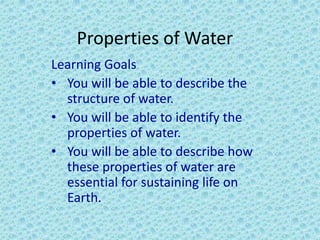
Properties of Water Presentation
- 1. Properties of Water Learning Goals • You will be able to describe the structure of water. • You will be able to identify the properties of water. • You will be able to describe how these properties of water are essential for sustaining life on Earth.
- 2. Water’s Structure • Water is a molecule made of two hydrogen atoms and one oxygen atom • The Hydrogen atoms have a slightly positive charge and the Oxygen atoms have a slightly negative charge
- 3. Polarity • Polar Molecule= a molecule that has one side that is more negative than the other. • The Oxygen atom is more negative than the Hydrogen atoms
- 4. 1. Think about the following… What are the atoms that make up a water molecule? Which type of bonds hold the atoms together? What does polarity mean? 2. Post your thoughts in Today’s Meet. Press Pause, Think, & Share
- 5. What did you discuss? • What are the atoms that make up a water molecule • 1 Oxygen atom and 2 Hydrogen atoms • Which type of bonds hold the atoms together • Covalent bond because the atoms share electrons • What does polarity mean? • Polar Molecule= a molecule that has one side that is more negative than the other.
- 6. • Polar molecule • Cohesion and Adhesion • High specific heat • Density – greatest at 4oC (AKA water floats) • Universal solvent • Neutral pH Properties of Water
- 7. • Water has a variety of unusual properties because of attractions between these polar molecules. – The slightly negative regions of one molecule are attracted to the slightly positive regions of nearby molecules, forming a hydrogen bond. – Each water molecule can form hydrogen bonds with up to four neighbors.
- 8. HYDROGEN BONDS • Hold water molecules together • The hydrogen bonds joining water molecules are weak, about 1/20th as strong as covalent bonds. • They form, break, and reform with great frequency • Extraordinary Properties that are a result of hydrogen bonds. – Cohesive behavior – Resists changes in temperature – High heat of vaporization – Expands when it freezes – Versatile solvent
- 9. Organisms Depend on Cohesion • Cohesion is responsible for the transport of the water column in plants Why is this important? • Cohesion among water molecules plays a key role in the transport of water against gravity in plants • Adhesion, clinging of one substance to another, contributes too, as water adheres to the wall of the vessels. Hydrogen bonds hold the substance together, a phenomenon called cohesion
- 10. • Surface tension, a measure of the force necessary to stretch or break the surface of a liquid, is related to cohesion. – Water has a greater surface tension than most other liquids because hydrogen bonds among surface water molecules resist stretching or breaking the surface. – Some animals can stand, walk, or run on water without breaking the surface.
- 11. Moderate Temperatures on Earth • Temperature is the measurement of the movement of atoms/molecules. • As water temperatures increase, hydrogen bonds begin to break. • As water temperatures cool, hydrogen bonds from more readily.
- 12. Why is this important? 1. Prevention of temperature changes that are outside the range suitable for life. 2. Coastal areas having a mild climate Specific Heat is the amount of heat that must be absorbed or lost for one gram of a substance to change its temperature by 1oC.
- 13. Evaporative Cooling • The cooling of a surface occurs when the liquid evaporates • This is responsible for: – Moderating earth’s climate – Stabilizes temperature in aquatic ecosystems – Preventing organisms from overheating
- 14. Density of Water • Most dense at 4oC • Contracts until 4oC • Expands from 4oC to 0oC Why is this important? 1. Prevents lakes from totally freezing so aquatic organisms can live 2. Ice forms on the surface first—the freezing of the water releases heat to the water below creating insulation. 3. Acts as hunting grounds for some organisms
- 15. Universal Solvent • Because of water’s polarity many compounds dissolve in water Why is this important • Most biochemical reactions involve solutes dissolved in water- we need to get stuff in our cells!
- 16. Neutral pH • pH Scale – Measures the degree of acidity (0 – 14) • Water has a pH around 7 Why is this important? • Most biological functions take place in a neutral pH
- 17. 1. Think about the following… Name as many properties of water as you can (Hint:There are 6) 2. Post your thoughts in Today’s Meet Press Pause, Think, & Share
- 18. What did you discuss? • What are the properties of water? – Polar molecule – Cohesion and Adhesion – High specific heat – Density – greatest at 4oC – Universal solvent – Neutral pH
- 19. • In OneNote make a table that has one column with the properties of water and another with why these properties are important. Fill the table in with what you know. Properties of Water Why these properties are important to life
